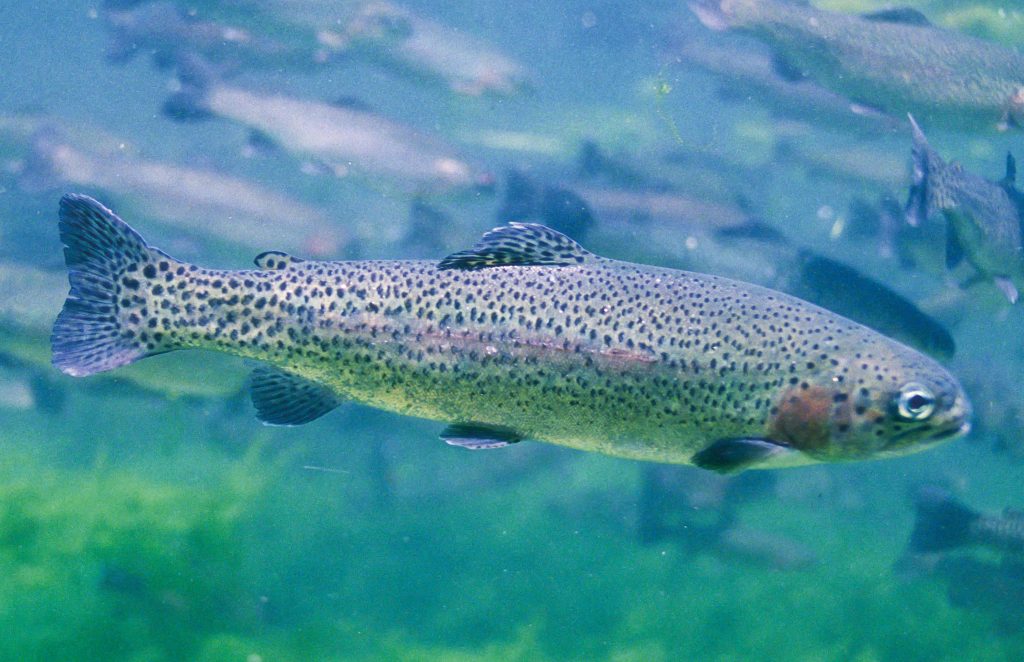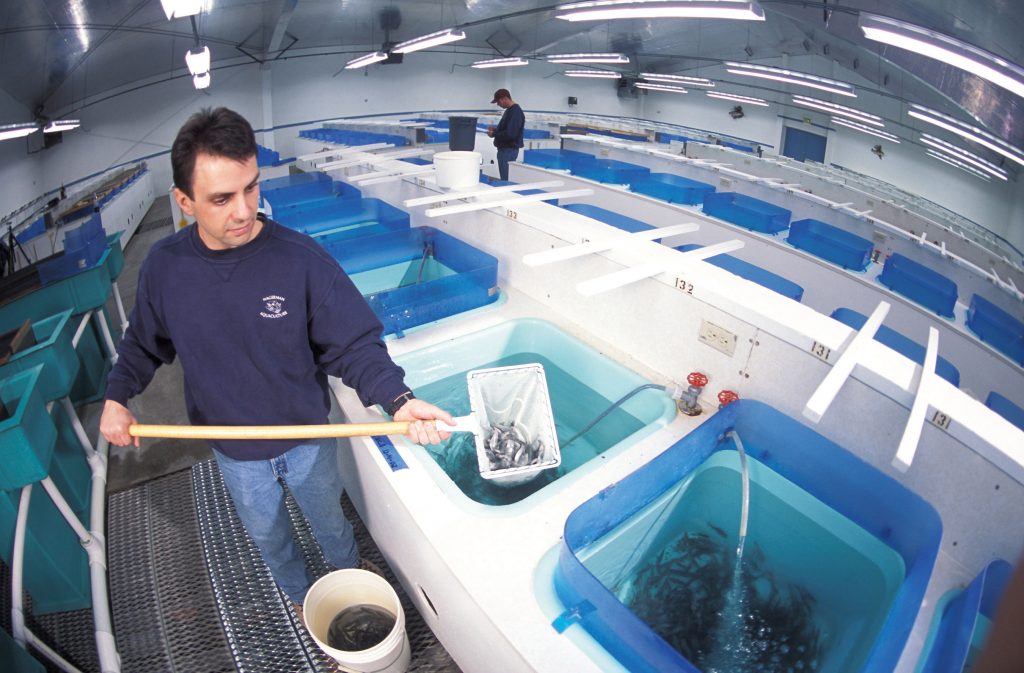Dr Ken Overturf – Securing a Sustainable Future for Aquaculture
To help feed a global population of the magnitude expected by 2050, fish farming will need to increase dramatically. Two main factors limiting the expansion and future sustainability of the aquaculture industry are finding feed replacements that have equivalent or improved nutritional benefits, and preventing disease. Over the last 20 years, Dr Ken Overturf and his team at the USDA’s Agricultural Research Service in collaboration with the Aquaculture Research Institute at the University of Idaho have been working to establish a genetic enhancement program for rainbow trout, with the aim of helping to boost global fish production in a sustainable manner.
An Industry Under Pressure
Aquaculture – the farming of fish, crustaceans, molluscs, aquatic plants and algae – is the fastest growing food-producing sector globally. It now provides close to half of all fish supplies for direct human food consumption – having risen from just 13% in 1990.
As the global population is expected to reach almost 10 billion by 2050, the Food and Agriculture Organisation (FAO) of the United Nations projects that food supplies will need to increase by 70% over current production. The contribution of aquaculture is expected to increase further, particularly with harvests from traditional fisheries being overexploited or depleted.
The fundamental question is whether the industry can expand with sufficient speed, yet remain sustainable. The two main factors determining aquacultural sustainability are fishmeal and fish oil replacements in feeds with alternative cost-effective ingredients, and the prevention and management of disease.
Manufactured from wild-caught fish and by-products from fish processing, fishmeal is a primary source of protein in aquacultural feeds. With the growth of aquaculture, there is insufficient fishmeal available to include in feeds at the levels currently used. Therefore, there is a great need to incorporate alternative sources of protein and oil into fish feeds. In several reported instances, higher levels of alternative protein sources, such as plant protein, have led to reduced growth, decreased feed efficiency, and higher mortality. Even so, replacing the protein in fish feeds with plant protein lessens the industry’s dependence on fishmeal, while also potentially reducing the amount of phosphorus in facility effluents, and thus decreasing water pollution.
The second major challenge facing global aquaculture is losses due to disease. In 2017 alone, total losses of all trout intended for sale amounted to 31.4 million fish, with diseases accounting for an astounding 94% of these losses. While preventative measures such as biosecurity, vaccinations and medications are used to help combat disease, there remains considerable room for improvement in both strategic efforts and in our fundamental understanding of fish diseases.

Improving Aquacultural Production
Over the last 20 years, Dr Ken Overturf from the United States Department of Agriculture’s Agricultural Research Service (USDA-ARS) has been exploring ways to boost global fish production in the aquaculture industry. His team and his collaborators in the University of Idaho’s Aquaculture Research Institute have conducted a range of in-depth studies, focusing on nutrition and disease, at the Hagerman Fish Culture Experiment Station.
‘The sustainable development of aquaculture is dependent on successful nutritional innovations and improvements in animal metabolic performance,’ says Dr Overturf. ‘A holistic approach incorporating the evaluation of production practices, fish physiology, feed formulations, disease therapeutants, and genetics are necessary to determine nutritional innovations and for optimising animal health, quality and performance, reducing feed costs and, ultimately, fostering sustainability of aquaculture.’
Through their work, his team has found that alternative food sources and management of disease must be examined in tandem, as nutrition and disease are intrinsically linked. ‘Among the alternative and sustainable diets that are currently being used, soybean is among the most attractive for fish feeds,’ explains Dr Overturf. ‘However, its use is limited by anti-nutritional plant compounds that reduce nutrient absorption, due to negative changes in the mucosal lining of the intestine, termed intestinal enteritis. Many aquaculture-related diseases are linked to mucosal changes, and there is also evidence that alteration of the intestinal mucosa may increase disease susceptibility through disturbance of the host’s natural microbiome.’

CREDIT: Stephen Ausmus
Harnessing Genetic Selection
Central to the team’s work has been the establishment of a genetic enhancement program for the selection of rainbow trout fed alternative plant-based diets, focusing on feed conversion, weight gain, evaluation of disease resistance, and development of enteritis. Rainbow trout are a useful model because they are highly domesticated, rapid-growing, and their relatively large size makes them suitable for studies that require large quantities of certain tissues.
In initial experiments, the team monitored the expression of specific genes in different families and strains of fish that were experimentally challenged with different feeds, environmental conditions or pathogenic microbes. Their results showed changes in gene expression correlating with changes in diet, metabolism, growth, strain, or immune response, and this work began to improve the team’s understanding of the effects of diet on nutrient utilisation and fish health. This research led to increasingly sophisticated analysis of differential responses and evaluating changes in the intestinal microbiome.
For aquaculture-reared fish, the fillet is the main product sold to consumers. Rather than increasing growth strictly by measuring weight gain, the team knew that it would be of greater commercial benefit to select for a production trait such as efficient muscle growth. Using the information gathered, they set about characterising the expression of genes that control muscle growth, to help them select strains of healthy fish with high-quality lean muscle that would be profitable for producers.
Dr Overturf and his colleagues also evaluated trout for their resistance to diseases, including bacterial cold-water disease and infectious haematopoietic necrosis. They found a significant positive correlation between final bodyweight and resistance to infectious haematopoietic necrosis, and early bodyweight and resistance to bacterial cold-water disease. These results show that at the time of infection, the weight of rainbow trout appears to correlate with survival, indicating a possible link between selecting for growth, while at the same time potentially reducing disease susceptibility. Furthermore, selection for growth and utilisation of plant-based feeds also showed correlations with enhanced non-specific pathogen resistance.
Taking their accumulated body of research into account, it became clear to Dr Overturf and his team that actively selecting rainbow trout for enhanced growth and utilisation of a fishmeal-free diet could have economic benefits in terms of plant-based nutrition, muscle growth, and reduced levels of disease. The team then used genetic selection to breed from those fish that exhibited favourable attributes when fed the plant-based diet. The result was a single strain of rainbow trout, which exhibited faster growth when fed a fishmeal-free, plant-based diet, without the development of intestinal enteritis. This was the first study whereby a stock of fish had been shown to grow faster and more efficiently when fed an all-plant based feed, compared with a fishmeal-based feed.
Dr Overturf’s team also carried out subsequent work to understand how dietary components are interactively processed and trigger molecular, tissue and whole-body responses. They used feeds with varying ratios of protein to fat, and measured the responses in terms of growth, gene expression and protein degradation. ‘Our results show that macronutrients are potent regulators of muscle development and growth,’ says Dr Overturf. ‘This work provides new opportunities to program performance and flesh quality of organisms. The next step is to integrate this quantitative knowledge into application for practical diet formulation and feeding programs.’

Understanding Disease Dynamics
The team has now carried out selective breeding through ten generations of rainbow trout. This has led to the development of a strain of trout that not only does well, but actually thrives, on an all-plant protein diet – growing twice as rapidly as its parental lines.
Interestingly, this strain of trout also shows non-specific disease resistance, and does not develop intestinal inflammation. The selected strain has been shown to have enhanced resistance to bacterial and viral diseases when compared to commercial strains and other trout selected for disease resistance over many generations. The team’s work has also revealed a commonality between the expression of a gene in rainbow trout that is implicated in ulcerative colitis and celiac disease in humans. This suggests that rainbow trout selected for plant-diet tolerance could have added utility as a potential biomedical model for human inflammatory bowel diseases.
One negative aspect of plant protein sources, such as soybean meal, is that they can interfere with digestion, causing a diarrhoea-like condition in rainbow trout. The resulting fine faecal particles can adversely affect aquaculture systems and the environment. The prevailing method used to determine faecal particle size requires expensive equipment and is labour intensive. New work carried out by Dr Overturf and his colleague Dr Thomas Welker has focused on developing a visual measurement method that separates faeces into different particle size classes but is also affordable and easy to use.
The team has also found that the addition of guar gum to a soybean diet can significantly improve the amount of large faecal particles – results that were easily detected with the team’s new visual classification method. The use of guar gum and other feed binders has the potential to increase the efficiency of waste collection systems in commercial trout aquaculture. Furthermore, the team is refining feed processing methods to increase feed utilisation and improve faeces stability, thereby reducing pollution in hatchery effluent. Improvements in solid waste management can improve animal welfare, reduce negative impacts on the environment, and enable development of aquaculture in a more sustainable way.
The team is currently working on plans to continue their work towards improving our understanding of fish-disease dynamics. Their latest research focuses on multi-disease resistance among trout strains with different genetic backgrounds, and identifying the differing gene responses involved. Dr Overturf believes a unique opportunity exists to develop efficient and economical health maintenance tools for disease in aquaculture.
‘The impact of actively improving nonspecific disease resistance against numerous pathogens, both bacterial and viral, through genetic selection would have a tremendous impact in decreasing economic losses to disease,’ says Dr Overturf. ‘This would also vastly decrease the cost of selection programs that attempt to specifically select individually for multiple problem pathogens.’
The team hopes that their work will be transferable to other fish species, with practical applications across the aquaculture industry as a whole. Farming strains of finfish that thrive on plant-based diets will help to prevent the demand for feed outstripping supply in the face of a growing global population, and allow the industry to develop sustainably.
In addition, the team’s work in improving disease resistance and nutrient utilisation could have huge economic impacts. In an industry where 90% of all losses are due to disease and more than half of production costs are related to feed, even single-digit improvements would be significant and could be valued in the millions. Overall, the breadth of this body of work, built up over a 20-year period, has widespread implications for the global aquaculture industry as a whole, with concurrent positive benefits for the environment and human health.
Reference
https://doi.org/10.33548/SCIENTIA515
Meet the researcher

Dr Kenneth Overturf
Hagerman Fish Culture Experiment Station
USDA – Agricultural Research Service
Hagerman, ID
USA
Dr Kenneth Overturf gained his PhD in Molecular and Cellular Biology from the University of Nevada-Reno in 1994. After undertaking several research roles, Dr Overturf began working for the USDA’s Agricultural Research Service (USDA-ARS) as a Research Geneticist in 2000. He is currently based at the University of Idaho’s Hagerman Fish Culture Experiment Station, located in south-central Idaho, near the centre of the US trout industry. For the past 20 years, one of Dr Overturf’s main research areas has been utilising genetic selection to improve fish production within the aquaculture industry, focusing on rainbow trout. Dr Overturf has authored more than 80 journal articles and publications in the fields of aquaculture and genetics. He is a respected member of the international aquaculture community, and has made a number of invited national and international presentations on his research.
CONTACT
E: ken.overturf@usda.gov
W: https://www.ars.usda.gov/people-locations/person/?person-id=13501
KEY COLLABORATORS
Dr Thomas Welker, ARS-USDA
Dr Brian Small, University of Idaho
Dr Madison Powell, University of Idaho
Dr Wendy Sealey, US Department of Fish and Wildlife
FUNDING
USDA-ARS
USDA-NIFA: Aquaculture
University of Idaho Aquaculture Research Initiative
Soy Aquaculture Alliance
FURTHER READING
T Welker, K Overturf, F Barrow. Development and evaluation of a volumetric quantification method for faecal particle size classification in rainbow trout fed different diets, North American Journal of Aquaculture, 2010, 82, 159.
J Abernathy, A Brezas, K Snekvik, R Hardy, K Overturf, Integrative functional analyses using rainbow trout selected for tolerance to plant diets reveal nutrigenomic signatures for soy utilization without the concurrence of enteritis, PlosOne, 2017, e0180972.
K Overturf, FT Barrows, RW Hardy, Effect and interaction of rainbow trout strain (Oncorhynchus mykiss) and diet type on growth and nutrient retention, Aquaculture Research, 2013, 44.
K Overturf, S LaPatra, R Towner, N Campbell, S Narum, Relationships between growth and disease resistance in rainbow trout Oncorhynchus mykiss (Walbaum), Journal of Fish Diseases, 2010, 33, 321.
K Overturf and TG Gaylord, Determination of relative protein degradation activity at different life stages in rainbow trout (Oncorhynchus mykiss), Comparative Biochemistry and Physiology Part B, 2009, 152, 150.
K Johansen and K Overturf, Quantitative expression analysis of genes affecting muscle growth in rainbow trout (Oncorhynchus mykiss), Marine Biotechnology, 2005, 7, 576.
K Overturf, D Bullock, S LaPatra, R Hardy, Genetic selection and molecular analysis of domesticated rainbow trout for enhanced growth on alternative diet sources. Environmental Biology of Fishes, 2004, 69, 409.
Creative Commons Licence
(CC BY 4.0)
This work is licensed under a Creative Commons Attribution 4.0 International License. 
What does this mean?
Share: You can copy and redistribute the material in any medium or format
Adapt: You can change, and build upon the material for any purpose, even commercially.
Credit: You must give appropriate credit, provide a link to the license, and indicate if changes were made.
More articles you may like
Grandmothers: Innovation Through Tradition
Grandmother Project – Change through Culture (GMP) is an organisation dedicated to documenting the role of grandmothers and demonstrating the effectiveness of grandmother-inclusive strategies in improving the health and well-being of women, children, and adolescents. GMP’s groundbreaking work challenges conventional wisdom to transform community-based interventions in Africa and beyond, harnessing a powerful but often overlooked resource: the wisdom and influence of grandmothers.
Dr Robert Larkin | Cultivating Change to Improve Soil Health and Increase Potato Yield
Environmental quality and food production are facing the pressing challenges of climate change and global population growth. Dr Robert Larkin from the United States Department of Agriculture-Agricultural Research Service (USDA-ARS) and a team of plant scientists developed and tested a range of crop management systems to help overcome these compounding challenges. Their work is improving soil health and increasing the yield of potato crops, contributing to the future food security of nations.
Professor Giorgio Buttazzo | Artificial Intelligence and a Crossroads for Humanity
Where do we stand with artificial intelligence? Might machines take over our jobs? Can machines become conscious? Might we be harmed by robots? What is the future of humanity? Professor Giorgio Buttazzo of Scuola Superiore Sant’Anna is an expert in artificial intelligence and neural networks. In a recent publication, he provides considered insights into some of the most pressing questions surrounding artificial intelligence and humanity.
Dr Ralf Adam | New Technologies Shaping the Future of Oral Hygiene
Understanding the efficiency of various toothbrush technologies is essential for achieving optimal oral health. Dr Ralf Adam, who leads a dedicated team at Procter & Gamble in Germany, is keen to investigate the complexities of these technologies. His team have provided new insights into the best toothbrush types for plaque removal and the maintenance of gum health. By highlighting the importance of informed oral care decisions and ongoing investigations, this vital research works towards ensuring everyone can achieve a brighter, healthier smile.




